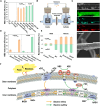Biological self-protection inspired engineering of nanomaterials to construct a robust bio-nano system for environmental applications
- PMID: 39292775
- PMCID: PMC11409965
- DOI: 10.1126/sciadv.adp2179
Biological self-protection inspired engineering of nanomaterials to construct a robust bio-nano system for environmental applications
Abstract
Nanomaterials can empower microbial-based chemical production or pollutant removal, e.g., nano zero-valent iron (nZVI) as an electron source to enhance microbial reducing pollutants. Constructing bio-nano interfaces is critical for bio-nano system operation, but low interfacial compatibility due to nanotoxicity challenges the system performance. Inspired by microorganisms' resistance to nanotoxicity by secreting extracellular polymeric substances (EPS), which can act as electron shuttling media, we design a highly compatible bio-nano interface by modifying nZVI with EPS, markedly improving the performance of a bio-nano system consisting of nZVI and bacteria. EPS modification reduced membrane damage and oxidative stress induced by nZVI. Moreover, EPS alleviated nZVI agglomeration and probably reduced bacterial rejection of nZVI by wrapping camouflage, contributing to the bio-nano interface formation, thereby facilitating nZVI to provide electrons for bacterial reducing pollutant via membrane-anchoring cytochrome c. This work provides a strategy for designing a highly biocompatible interface to construct robust and efficient bio-nano systems for environmental implication.
Figures







Similar articles
-
Multiple roles of extracellular polymeric substance in nitrobenzene reduction by nano-sized zero-valent iron in water and their mechanism.Environ Technol. 2022 Jan;43(1):21-33. doi: 10.1080/09593330.2020.1772376. Epub 2020 Jun 9. Environ Technol. 2022. PMID: 32431242
-
Magnetic nanocomposite microbial extracellular polymeric substances@Fe3O4 supported nZVI for Sb(V) reduction and adsorption under aerobic and anaerobic conditions.Environ Res. 2020 Oct;189:109950. doi: 10.1016/j.envres.2020.109950. Epub 2020 Jul 15. Environ Res. 2020. PMID: 32980022
-
Nanoscale zero-valent iron alleviated horizontal transfer of antibiotic resistance genes in soil: The important role of extracellular polymeric substances.J Hazard Mater. 2024 Dec 5;480:135902. doi: 10.1016/j.jhazmat.2024.135902. Epub 2024 Sep 18. J Hazard Mater. 2024. PMID: 39303615
-
Integration of organohalide-respiring bacteria and nanoscale zero-valent iron (Bio-nZVI-RD): A perfect marriage for the remediation of organohalide pollutants?Biotechnol Adv. 2016 Dec;34(8):1384-1395. doi: 10.1016/j.biotechadv.2016.10.004. Epub 2016 Oct 17. Biotechnol Adv. 2016. PMID: 27765723 Review.
-
Microbes team with nanoscale zero-valent iron: A robust route for degradation of recalcitrant pollutants.J Environ Sci (China). 2022 Aug;118:140-146. doi: 10.1016/j.jes.2021.12.037. Epub 2022 Jan 4. J Environ Sci (China). 2022. PMID: 35305763 Review.
References
-
- Logan B. E., Rabaey K., Conversion of wastes into bioelectricity and chemicals by using microbial electrochemical technologies. Science 337, 686–690 (2012). - PubMed
-
- Rabaey K., Rozendal R. A., Microbial electrosynthesis—Revisiting the electrical route for microbial production. Nat. Rev. Microbiol. 8, 706–716 (2010). - PubMed
-
- Keasling J., Garcia Martin H., Lee T. S., Mukhopadhyay A., Singer S. W., Sundstrom E., Microbial production of advanced biofuels. Nat. Rev. Microbiol. 19, 701–715 (2021). - PubMed
-
- Kornienko N., Zhang J. Z., Sakimoto K. K., Yang P., Reisner E., Interfacing nature’s catalytic machinery with synthetic materials for semi-artificial photosynthesis. Nat. Nanotechnol. 13, 890–899 (2018). - PubMed
-
- Stauber R. H., Siemer S., Becker S., Ding G.-B., Strieth S., Knauer S. K., Small meets smaller: Effects of nanomaterials on microbial biology, pathology, and ecology. ACS Nano 12, 6351–6359 (2018). - PubMed
MeSH terms
Substances
LinkOut - more resources
Full Text Sources

